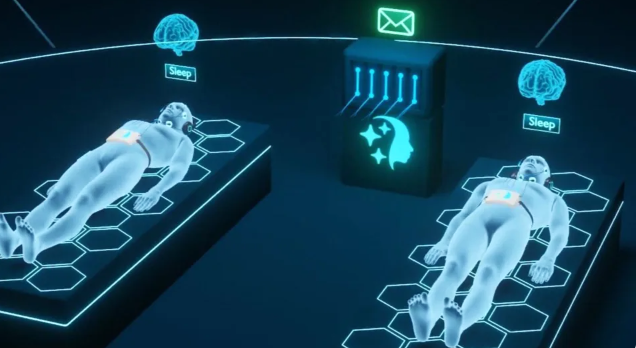
Lucid Dreaming Study
In a world first, a new study conducted by a California-based neurotechnology company has recorded two-way communication between sleeping individuals during lucid dreaming.
PROCEED TO Lucid dreaming study: First ever two-way communication during sleep recorded
Exploring the World of Lucid Dreaming
Introduction
Lucid dreaming is a fascinating phenomenon where the dreamer becomes aware that they are dreaming and may even gain some control over the dream’s narrative, environment, or actions. This unique state of consciousness has captivated scientists, psychologists, and spiritual seekers alike, offering a blend of self-exploration, creativity, and potential therapeutic benefits.
In this article, we’ll dive into what lucid dreaming is, how it works, its benefits, and practical techniques to experience it yourself.
What is Lucid Dreaming?
A lucid dream occurs when you realize you’re dreaming while still in the dream state. Unlike regular dreams, where you’re often a passive participant, lucid dreams allow you to actively shape the dream’s outcome. For example, you might decide to fly, confront a dream character, or explore an imagined world. The term “lucid dreaming” was coined by Dutch psychiatrist Frederik van Eeden in 1913, though the practice has roots in ancient traditions like Tibetan Buddhism.
Lucid dreams typically happen during the Rapid Eye Movement (REM) stage of sleep, when brain activity resembles wakefulness. Studies suggest that about 55% of people have experienced at least one lucid dream in their lifetime, with some individuals, known as “natural lucid dreamers,” experiencing them regularly.
The Science Behind Lucid Dreaming
Neuroscientists have studied lucid dreaming to understand consciousness and the brain’s activity during sleep. Research using electroencephalography (EEG) and functional magnetic resonance imaging (fMRI) shows that lucid dreaming involves heightened activity in the prefrontal cortex, the brain region responsible for self-awareness and decision-making. This explains why lucid dreamers can think critically and exert control over their dreams.
One landmark study by Stephen LaBerge at Stanford University in the 1980s demonstrated that lucid dreamers could communicate with the outside world. Participants were trained to signal they were lucid by performing specific eye movements during REM sleep, which were detected by researchers. This confirmed that lucid dreaming is a distinct state between waking and non-lucid dreaming.
Benefits of Lucid Dreaming
Lucid dreaming offers a range of potential benefits, both psychological and creative:
Overcoming Nightmares: Lucid dreaming can help individuals confront and control recurring nightmares, reducing fear and anxiety. By realizing it’s just a dream, you can transform a threatening scenario into a neutral or positive one.
Enhancing Creativity: Artists, writers, and musicians use lucid dreams to explore imaginative scenarios and generate ideas. The dream world’s limitless possibilities can inspire innovative thinking.
Practicing Skills: Some studies suggest that practicing tasks in a lucid dream, like playing an instrument or rehearsing a speech, can improve real-world performance, as the brain simulates these actions similarly to wakeful practice.
Emotional Healing: Lucid dreaming may allow individuals to process trauma or unresolved emotions by engaging with dream characters or scenarios in a safe, controlled environment.
Pure Fun: Let’s not forget the thrill of flying over mountains, exploring fantastical worlds, or meeting dream versions of your favorite characters. Lucid dreaming can be an exhilarating adventure.
How to Start Lucid Dreaming
While some people lucid dream spontaneously, most need to practice specific techniques to induce it. Here are some proven methods to get started:
- Keep a Dream Journal
Record your dreams immediately upon waking to improve dream recall. Write down every detail you can remember, including emotions, settings, and characters. Over time, this helps you recognize recurring “dream signs” (unusual elements like flying or distorted physics) that can trigger lucidity.
- Reality Checks
Perform reality checks throughout the day to build a habit of questioning whether you’re awake or dreaming. Common checks include:
Pinch your nose and try to breathe: In a dream, you can often breathe through a pinched nose.
Look at your hands: In dreams, hands may appear distorted or have extra fingers.
Read text or check the time: Text and clocks often change or behave erratically in dreams.
If you make reality checks a habit, you’re more likely to do them in a dream, triggering lucidity.
- Mnemonic Induction of Lucid Dreams (MILD)
Before bed, repeat a phrase like, “Tonight, I will know I’m dreaming,” while visualizing yourself becoming lucid in a dream. This technique, developed by Stephen LaBerge, primes your mind to recognize the dream state.
- Wake Back to Bed (WBTB)
Set an alarm to wake you after 5-6 hours of sleep, stay awake for 15-30 minutes (reading about lucid dreaming can help), then go back to sleep with the intention of lucid dreaming. This increases your chances of entering REM sleep while still conscious.
- Use External Stimuli
Devices like lucid dreaming masks detect REM sleep and flash lights or play sounds to signal you’re dreaming without waking you. These cues can help you become lucid, though they’re not essential for success.
Challenges and Considerations
Lucid dreaming is generally safe, but there are a few things to keep in mind:
Sleep Disruption: Techniques like WBTB can interrupt sleep, so avoid overdoing them if you’re sleep-deprived.
Sleep Paralysis: Some lucid dreamers experience sleep paralysis, a temporary inability to move while falling asleep or waking. While harmless, it can be unsettling. Staying calm and focusing on small movements (like wiggling a finger) can help you wake up.
False Awakenings: You might think you’ve woken up but are still dreaming. Regular reality checks can help you catch these.
If you have a history of mental health issues, consult a professional before actively pursuing lucid dreaming, as it can sometimes blur the line between reality and dreams.
Cultural and Spiritual Perspectives
Lucid dreaming isn’t just a modern fascination. In Tibetan Buddhism, “dream yoga” uses lucid dreaming as a spiritual practice to prepare for death and achieve enlightenment. Indigenous cultures, like some Native American tribes, have viewed dreams as portals to spiritual realms, with lucid dreaming seen as a way to commune with ancestors or spirits.
In pop culture, lucid dreaming has been popularized by films like Inception (2010), which explores the idea of navigating and controlling dream worlds. While the movie takes creative liberties, it sparked widespread interest in the topic.
Conclusion
Lucid dreaming opens a doorway to a world where your imagination knows no bounds. Whether you’re seeking personal growth, creative inspiration, or just a thrilling adventure, mastering lucid dreaming can be a rewarding journey. By practicing techniques like dream journaling, reality checks, and MILD, you can unlock the ability to explore your subconscious with awareness and control. So, why not start tonight? Your dream world is waiting.
DISCOVER the new technology that can help you increase your brain power.
🥰 => Money Wave
*** Many users report noticeable improvements in their
. financial situation,
. luck, and
. opportunities
after using The Money Wave.


